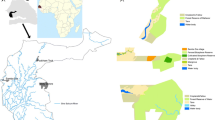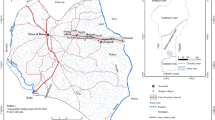Abstract
Remnant trees may play an important role in conserving biodiversity within agricultural systems because they provide habitats and resources that are otherwise absent from agricultural landscapes. In order to determine the potential importance of remnant trees for conservation, we surveyed the density and species composition of remnant trees occurring in pastures of 24 dairy farms near Monteverde, Costa Rica. In addition, we conducted interviews with farmers to determine why they leave trees in pastures and how they manage them. In our survey of 237 ha of pastures, we counted 5583 trees of 190 species (mean density of 25 trees/ha). Primary forest trees accounted for 57% of all of the species and 33% of tree individuals. Over 90% of the species are known to provide food for forest birds and other animals. In addition, many of the species are important locally for humans as sources of timber (37%), firewood (36%) or fence posts (20%). Farmers mentioned 19 reasons for leaving trees in pastures. Of these, shade for cattle, timber, fruits for birds and fence posts were most commonly cited. Most farmers were well aware of both the economic and ecological benefits of pasture trees, and were interested in the possibility of increasing tree cover within their pastures. Although the current densities and richness of pasture trees in Monteverde are high, the size distribution indicates that diversity will decrease substantially in future years, both because farmers are harvesting trees and because saplings of primary forest trees are scarce within the pastures.
Similar content being viewed by others
References
Bolaños RA and Watson V (1993) Mapa ecológico de Costa Rica según el sistema de clasificación de zonas de vida del mundo de L. R. Holdridge. Centro Científico Tropical, San José, Costa Rica
Budowski G (1981) Agroforestry in Central America. In: Agroforestry: proceedings of a seminar held in CATIE (pp 13–40). Turrialba, Costa Rica.
Budowski G (1987) Living fences in tropical America, a widespread agroforestry practice. In: Gholz HL (ed) Agroforestry: Realities, Possibilities and Potentials, pp 169–178. Martinus Nijhoff Publishers, the Netherlands
DeRosier D (1995) Agricultural windbreaks: conservation and management implications of corridor usage by avian species. MS thesis, School of the Environment, Duke University
Estrada A, Coates-Estrada R and Meritt Jr. D (1993a) Bat species richness and abundance in tropical rain forest fragments and in agricultural habitats at Los Tuxtlas, Mexico. Ecography 16: 309–318
Estrada A, Coates-Estrada R, Meritt Jr. D, Montiel S and Curiel D (1993b) Patterns of frugivore species richness and abundance in forest islands and in agricultural habitats at Los Tuxtlas, Mexico. Vegetatio 107/108: 245–257
Gall GAE and Orians GH (1992) Agriculture and biological conservation. Agriculture, Ecosystems and Environment 42: 1–8
Greenberg R (1989) Forest migrants in non-forest habitats on the Yucatan Peninsula. In: Hagan JM and Johnston DW (eds) Ecology and Conservation of Neotropical Migrant Landbirds, pp 273–286. Smithsonian Institution Press, Washington DC
Guevara S, Purata SE and Van de Maarel E (1986) The role of remnant forest trees in tropical secondary succession. Vegetatio 66: 77–84
Guevara S, Meave J, Moreno-Casasola P and Laborde J (1992) Floristic composition and structure of vegetation under isolated trees in neotropical pastures. Journal of Vegetation Science 3: 655–664
Guevara S and Laborde L (1993) Monitoring seed dispersal at isolated standing trees in tropical pastures: consequences for local species availability. Vegetatio 107/108: 319–338
Guevara S, Meave J, Moreno-Casasola P, Laborde J and Castillo S (1994) Vegetación y flora de potreros en la sierra de los Tuxtlas, Mexico. Acta Botánica Mexicana 28: 1–27
Guindon C (1988) Protection of habitat critical to the Resplendent Quetzal (Pharomacrhus mocinno) on private land bordering the Monteverde Cloud Forest Reserve. MS Thesis. Ball State University, Muncie, Iowa
Guindon C (1996) The importance of forest fragments to the maintenance of regional biodiversity in Costa Rica. In: Schelhas J and Greenberg R (eds) Forest Patches in Tropical Landscapes, pp 168–186. Island Press, Washington DC
Guindon C (1997) The importance of forest fragments to the maintenance of regional biodiversity surrounding a tropical montane reserve, Costa Rica. PhD Dissertation. Faculty of the School of Forestry and Environmental Studies, Yale University
Haber WA, Zuchowski W and Bello E (1996) An introduction to cloud forest trees: Monteverde, Costa Rica. Impresión Comercial, La Nacion, San José, Costa Rica
Haber WA (in press) Plants and the vegetation of Monteverde. In: Nadkarni N and Wheelwright N (eds) The Ecology and Natural History of Monteverde. Oxford University Press, New York
Harvey CA (1999) The colonization of agricultural windbreaks by forest trees in Costa Rica: implications for forest regeneration. PhD Dissertation. Department of Ecology and Systematics, Cornell University
Harvey CA (in press) Windbreaks as habitats for forest trees. In: Nadkairni N and Wheelwright N (eds) The Ecology and Natural History of Monteverde. Oxford University Press, New York
Hietz-Seifert U, Hietz P and Guevara S (1996) Epiphyte vegetation and diversity on remnant trees after forest clearance in southern Veracruz, Mexico. Biological Conservation 75: 103–111
Janzen DH and Vásquez-Yanes C (1991) Aspects of tropical seed ecology of relevance to management of tropical forested wildlands. In: Gomez-Pompa A, Whitmore TC and Hadly M (eds) Rain Forest Regeneration and Management, pp 137–157. Man and the Biosphere Series, UNESCO, Paris, France
Kent M and Coker P (1992) Vegetation description and analysis: a practical approach. John Wiley and Sons, New York, 363 pp
Lynch JF (1989) Distribution of overwintering Neoarctic migrants in the Yucatan Peninsula, I. General patterns of occurrence. Condor 91: 515–544
Marmillod A (1989) Actitudes de los finqueros hacia los arboles. In: Beer JW, Fassbender HW and Heuveldgs J (eds) Advances en la investigación agroforestal, pp 294–306. CATIE, Turrialba, Costa Rica
Martinez HA (1989) El componente forestal en los sistemas de finca de pequeños agricultores. CATIE, Turrialba, Costa Rica
McClanahan TR and Wolfe RW (1993) Accelerating forest succession in a fragmented landscape: the role of birds and perches. Conservation Biology 7(2): 279–288
Montagnini F (1992) Sistemas agroforestales: principios y aplicaciónes en los trópicos. Organización de Estudios Tropicales, San José, Costa Rica, 622 pp
Nadkarni NM and Matelson TJ (1989) Bird use of epiphyte resources in neotropical trees. The Condor 91: 891–907
Nepstad DC, Uhl C and Serraõ EAS (1991) Recuperation of a degraded Amazonian landscape: forest recovery and agricultural restoration. Ambio 20: 248–255
Noss RF and Harris LD (1986) Nodes, networks and MUMs: preserving diversity at all scales. Environmental Management 10: 299–309
Parrotta JA (1992) The role of plantation forests in rehabilitating degraded tropical ecosystems. Agriculture, Ecosystems, and Environment 41: 115–133
Perfecto I, Rice RA, Greenberg R and Van der Voort ME (1996) Shade coffee: a disappearing refuge for biodiversity. BioScience 46(8): 598–608
Pimentel D, Stachow U, Tackacs DA, Brubaker HW, Dumas AR, Meany JJ, O'Neil JAS, Onsi DE and Corzilius DB (1992) Conserving biological diversity in agricultural/forestry systems. BioScience 42(5): 354–362
Powell G, Rappole JH and Sader JA (1989) Neotropical migrant landbird use of lowland Atlantic habitats in Costa Rica: a test of remote sensing for identification of habitat. In: Hagan JM and Johnston DW (eds) Ecology and Conservation of Neotropical Migrant Landbirds, pp 287–298. Smithsonian Institution Press, Washington DC
Powell G and Bjork R (1995) Implications of intratropical migration on reserve design: a case study using Pharomachrus mocinno. Conservation Biology 9(2): 354–362
Rai RSV (1988) Agroforestry in Costa Rica–a paradigm for the Indian sub-humid and humid tropics. Myforest 24(4): 249–255
Robbins DS, Dowell BA, Dawson DK, Colón JA, Estrada R, Sutton A, Sutton R and Weyer D (1989) Comparison of Neotropical migrant landbird populations wintering in tropical forest, isolated forest fragments, and agricultural habitats. In: Hagan JM and Johnston DW (eds) Ecology and Conservation of Neotropical Migrant Landbirds, pp 207–220. Smithsonian Institution Press, Washington DC
Saab V and Petit DR (1992) Impact of pasture development on winter bird communities in Belize, Central America. The Condor, 66–71.
SAS Institute Inc. (1996) JMP for the Macintosh, Version 3.1.6. Cary, NC
Schelhas J and Greenberg R (1993) Forest patches in the tropical landscape and the conservation of migratory birds. Smithsonian Migratory Bird Center, Migratory Bird Conservation Policy paper no. 1., Washington DC, 57 pp
Schelhas J (1996) Land use choice and change: intensification and diversification in the lowland tropics of Costa Rica. Human Organization 55(3): 298–306
Somarriba E (1986) Effects of livestock on seed germination of guava (Psidium guajavaL.) Agroforestry Systems 4: 233–238
Somarriba E (1988) Pasture growth and floristic composition under the shade of guava (Psidium guajavaL.) trees in Costa Rica. Agroforestry Systems 6: 153–162.
Stiles FG (1988) Altitudinal movements of birds on the Caribbean slope of Costa Rica: implications for conservation. In: Almeda F and Pringle C (eds) Tropical Rainforests: Diversity and Conservation, pp 243–258. California Academy of Sciences, San Francisco
Uhl C, Clark K, Clark H and P Murphy (1981) Early plant succession after cutting and burning in the Upper Rio Negro region of the Amazon Basin. Journal of Ecology 69: 631–649
Uhl C, Clark H, Clark K and Maquirino P (1982) Successional patterns associated with slas-hand-burn agriculture in the Upper Rio Negro region of the Amazon basin. Biotropica 14(4): 249–254
Wheelwright N (1983) Fruits and the ecology of resplendent quetzals. Auk 100: 286–301
Author information
Authors and Affiliations
Corresponding author
Rights and permissions
About this article
Cite this article
Harvey, C.A., Haber, W.A. Remnant trees and the conservation of biodiversity in Costa Rican pastures. Agroforestry Systems 44, 37–68 (1998). https://doi.org/10.1023/A:1006122211692
Issue Date:
DOI: https://doi.org/10.1023/A:1006122211692




